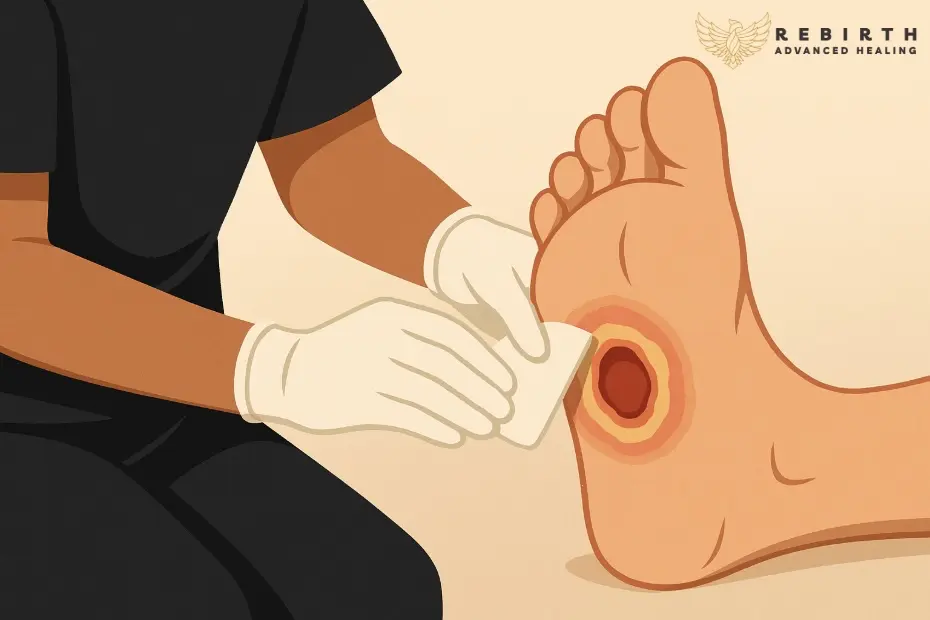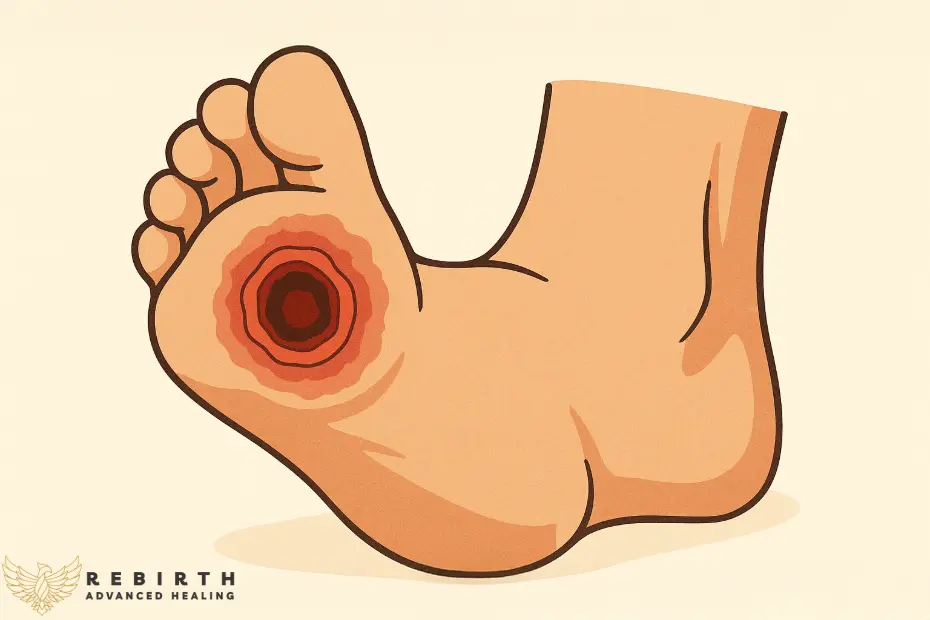A diabetic foot ulcer is a common type of wound that occurs in people with diabetes. This type of wound typically starts by people losing sensation in their feet and not noticing a minor cut or blister that ultimately develops into an ulcer.
Diabetics often deal with high blood sugar and poor circulation, which leads to oxygen and nutrient deficiency in the tissues, making these types of wounds difficult to heal.
At Rebirth Advanced Healing, a diabetic foot ulcer is one of the more common types of chronic wounds we work to heal. When traditional wound care treatments aren’t successful, we use advanced placental grafts to close the wound and help patients regain comfort and mobility.
Treatment is critical, no matter the type. Ignoring a diabetic foot ulcer can lead to bone infections, amputation, and even death.
“We’ve seen firsthand how early intervention can prevent life-altering complications,” said Dr. Chris Mason, physician-owner of Rebirth Advanced Healing.
In this article, you’ll learn about the common causes of diabetic foot ulcers, how to best treat these types of wounds, and how to prevent them from returning in the future.
What Does a Diabetic Foot Ulcer Look Like?
A diabetic foot ulcer is an open wound that typically forms on the bottom of the foot. Usually round- or oval-shaped with clearly defined edges, the overall size of the wound depends on its severity and the repetitive stress of that area of the foot.
This type of wound typically features a clear fluid or yellow pus, and the discharge is often foul smelling. The skin around the wound often appears red or swollen.
When an ulcer goes undetected and infection sets in, it’s possible the wound could have black edges (possible gangrene). If that’s the case, immediate medical attention is required.
What Are the Causes of Diabetic Foot Ulcers?
Most diabetic foot ulcers start silently, caused by nerve damage from diabetes that makes it hard to feel a cut, blister, or pressure forming.
Over time, excess glucose in the bloodstream (high blood sugar) damages small blood vessels, which supply the nerves. This leads to reduced oxygen and nutrient delivery, essentially starving, then permanently injuring the nerves.
When a patient can’t feel the pain, pressure, or temperature of their feet, they likely continue to walk on a blister or pressure point without even noticing. When they miss early signs of skin breakdown, that’s when an ulcer can form.
Additionally, nerve damage can cause foot deformities, which create abnormal pressure points while walking, opening the door for more wounds.
Nerve damage is only part of the problem. Poor circulation from diabetes means even small wounds or blisters don’t heal like they should, turning minor issues into major risks.
Once the skin breaks, it’s susceptible to bacteria and infection — and can become a challenging chronic wound.
How Do You Treat Diabetic Foot Ulcers?
After evaluating the ulcer’s depth, size, and infection status, There are three main steps to treating diabetic foot ulcers.
Relieve Pressure
An untreated ulcer gets worse with each step, which is why it’s important to remove pressure (also referred to as offloading) through contact casts, removable cast walkers, or special offloading shoes. Inadequate offloading is a leading cause of poor healing.
Wound Preparation and Infection Control
Debridement — the removal of dead or unhealthy tissue from a wound — and the management of fluid (known as exudate) is a staple of traditional wound care. When you clean out the bad stuff around the wound, it increases the chances of growing back healthy tissue. Proper dressings keep things clean and antibiotics help the healing process.
Advanced Wound Care If Necessary
When traditional wound care treatments don’t impact hard-to-heal ulcers, it might be time to consider advanced treatments, including placental grafts or negative pressure therapy (also known as wound vac therapy).
Recent studies have shown that placental tissue therapies can be a game-changer for hard-to-heal diabetic foot ulcers.
“These treatments are packed with natural growth factors and stem cells that help jumpstart the body’s healing process,” Mason said.
How to Prevent Diabetic Ulcers

In addition to regular visits with your doctor and any specialists, there are three strategies in preventing diabetic ulcers.
- Daily Foot Checks. The sooner a patient can identify a cut or blister — or even signs of redness — the better the outcome.
- Wear Proper Footwear. Well-fitting shoes protect your feet from pressure and friction, which cause the wound in the first place.
- Blood Sugar Control. In order to improve circulation and overall skin health, a patient needs to keep their blood glucose levels in an appropriate range to reduce ulcer risk.
In addition to treating Ulcers, Rebirth Advanced Healing’s care team works with patients to help prevent future wounds.
“Our team will check shoes, review foot care routines, and answer those questions that come up between appointments,” Mason said.
Like most medical conditions, early detection is your best fight against chronic wounds. When in doubt, check in with your care team to make sure you’re on the right track.
Medical and Insurance for Diabetic Ulcers
The chart below details ICD-10-CM diagnosis codes and associated CPT codes for diabetic ulcer treatments.
ICD-10CM Diagnosis Codes for Diabetic Ulcers
| ICD-10-CM Code | Description |
| E08.621 | Diabetes mellitus due to underlying condition with foot ulcer |
| E09.621 | Drug or chemical induced diabetes mellitus with foot ulcer |
| E10.621 | Type 1 diabetes mellitus with foot ulcer |
| E11.621 | Type 2 diabetes mellitus with foot ulcer |
| E13.621 | Other specified diabetes mellitus with foot ulcer |
| L97.4- | Non-pressure chronic ulcer of heel and midfoot (requires additional specificity) |
| L97.5- | Non-pressure chronic ulcer of other part of foot (requires additional specificity) |
Common CPT Codes of Diabetic Ulcer Treatment
| CPT Code | Description |
| 97597 | Debridement (e.g., high-pressure waterjet, sharp selective debridement with scissors, scalpel and forceps), open wound, (e.g., fibrin, devitalized epidermis and/or dermis, exudate, debris, biofilm), including topical application(s), wound assessment, and instruction(s) for ongoing care, per session; total wound(s) surface area; first 20 square centimeters or less |
| 97598 | Each additional 20 square centimeters, or part thereof (List separately in addition to code for primary procedure) |
| 11042 | Debridement, subcutaneous tissue (includes epidermis and dermis, if performed); first 20 square centimeters or less |
| 11045 | Each additional 20 square centimeters, or part thereof (List separately in addition to code for primary procedure) |
| 15271 | Application of skin substitute graft to trunk, arms, legs, total wound surface area up to 100 square centimeters; first 25 square centimeters or less |
| 15272 | Each additional 25 square centimeters, or part thereof (List separately in addition to code for primary procedure) |
Don’t Wait for a Small Problem to Become a Big One
Diabetic Ulcers rarely start from a dramatic injury. They start with a small sore, and if they go unnoticed, they can easily become a serious wound. That’s why early detection and expert care matter.
If you or a loved one has diabetes and are potentially dealing with an ulcer, contact us for specialized wound care, or to simply get your questions answered.
